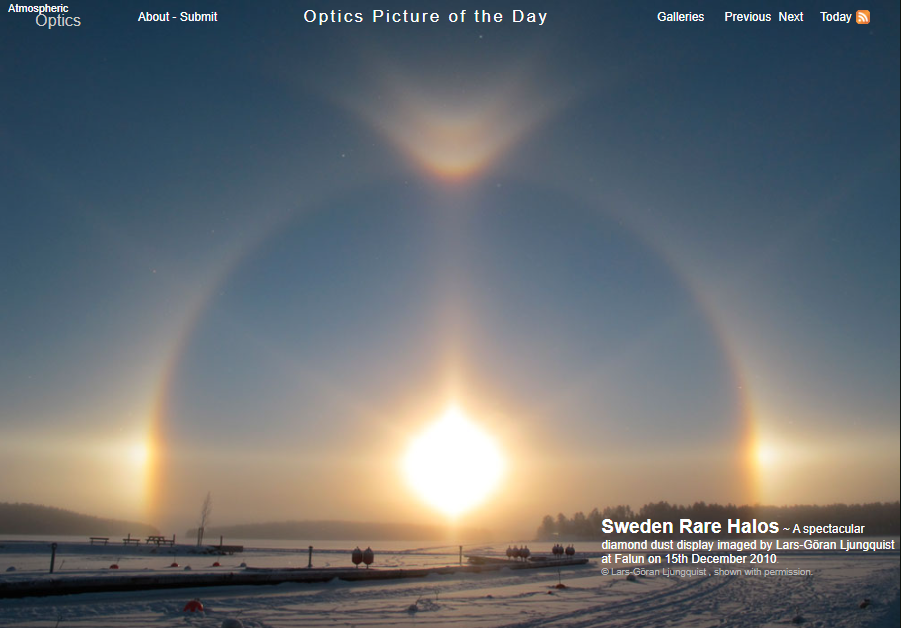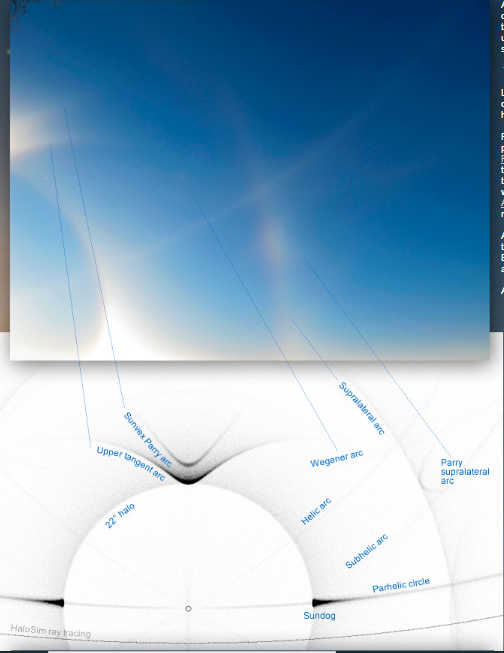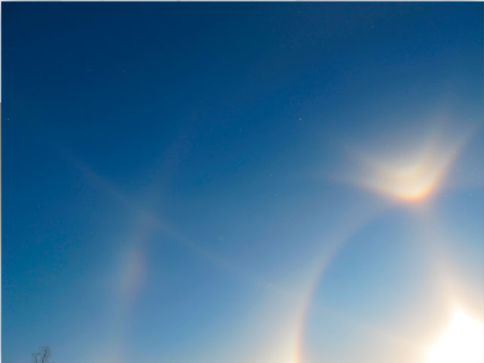OPOD - Sweden Rare Halos
OPOD - Sweden Rare Halos: A Mesmerizing Display of Atmospheric Optics
On the 15th of December 2010, Lars-Göran Ljungquist captured a breathtaking diamond dust display in Falun, Sweden. The images he captured showcase an array of rare and captivating atmospheric optical phenomena. Let's delve into the details of this remarkable event and explore the various halos and arcs that graced the sky that day.
As the low sun graced the horizon, a prominent 22° halo encircled it. Flanking the halo on each side were dazzling sundogs, creating a mesmerizing sight. Cutting through these phenomena was a parhelic circle, which swept across the sun itself. Rising from the 22° halo, a sun pillar extended upwards and was topped by a distinctive 'V' shaped upper tangent arc.
However, these are not your everyday halos. In this exceptional display, light reflected from the outer faces of Parry-oriented column crystals resulted in remarkably bright helic arcs extending outwards from the sun. These arcs, previously known as heliac arcs, added an extra layer of brilliance to the scene.
The presence of Parry crystals became even more apparent with the appearance of a second bright 'V' shaped halo, known as a sunvex Parry arc, positioned above the upper tangent arc. Moving further away from the sun and touching an 'ordinary' supralateral arc, we encountered rare Parry supralaterals. These unique phenomena were once exclusively observed in the ideal ice crystal regime of Antarctica. However, with the introduction of ski-slope snow machines, crystals seeded by these machines have been known to produce them as well.
Examining the image on the left, we can observe a faint Wegener arc resulting from a tortuous ray path through horizontal column crystals. Though subtle, this arc adds to the overall magnificence of the display. Furthermore, with a little image enhancement and a touch of imagination, we can discern a trace of a subhelic arc, further highlighting the complexity of the atmospheric optics on that day.
The stunning spectacle witnessed in Sweden was made possible by ice crystals that had aligned themselves aerodynamically in just four distinct ways. These crystal orientations played a crucial role in producing the wide array of halos and arcs that adorned the sky. Such occurrences serve as a reminder of the sheer beauty and intricacy of the natural world around us.
In conclusion, the rare halos witnessed in Sweden on that memorable day provided a captivating display of atmospheric optics. From the 22° halo and sundogs to the helic arcs and Parry supralaterals, each phenomenon added its own unique touch to the spectacle. The presence of Parry crystals, previously confined to Antarctica, showcased how even man-made snow crystals can contribute to the creation of these remarkable optical displays. The images captured by Lars-Göran Ljungquist serve as a testament to the wonders of nature and the enchanting phenomena that can occur in our skies.

Sweden Rare Halos ~ A spectacular diamond dust display imaged by Lars-Göran Ljungquist at Falun on 15th December 2010.
© Lars-Göran Ljungquist , shown with permission.

AtmosphericOptics
About - Submit Optics Picture of the Day Galleries Previous Next Today Subscribe to Features on RSS Feed
OpticsPOD - Optics Picture of the Day - OPOD | Today - Galleries - Submit Image - Atmospheric Optics
A 22° halo circles the low sun. At each side there are dazzling bright sundogs. A parhelic circle sweeps through them and the sun itself. A sun pillar reaches upwards to the 22° halo where it is topped by a ‘V’ shaped upper tangent arc.
There the ‘everyday’ halos (if only they were) end.
Light reflected from the outer faces of Parry oriented column crystals gives amazingly bright helic (old name heliac) arcs extending out from the sun.
Parry crystals make themselves further evident in producing the second bright ‘V’ shaped halo, a sunvex Parry arc, above the upper tangent arc. Further from the sun and touching an ‘ordinary’ supralateral arc there are rare Parry supralaterals. At one time these were only seen in the ideal ice crystal regime of Antarctica but now crystals seeded by ski-slope snow machines sometimes produce them.
At left the image reveals a faint Wegener arc from a tortuous ray path through horizontal column crystals. Below it, image enhancement helped a little by averted imagination hints at a trace of a subhelic arc.
An outstanding spectacle from ice crystals aerodynamically oriented in just four ways.

Note: this article has been automatically converted from the old site and may not appear as intended. You can find the original article here.
Reference Atmospheric Optics
If you use any of the definitions, information, or data presented on Atmospheric Optics, please copy the link or reference below to properly credit us as the reference source. Thank you!
-
<a href="https://atoptics.co.uk/blog/opod-sweden-rare-halos/">OPOD - Sweden Rare Halos</a>
-
"OPOD - Sweden Rare Halos". Atmospheric Optics. Accessed on April 20, 2024. https://atoptics.co.uk/blog/opod-sweden-rare-halos/.
-
"OPOD - Sweden Rare Halos". Atmospheric Optics, https://atoptics.co.uk/blog/opod-sweden-rare-halos/. Accessed 20 April, 2024
-
OPOD - Sweden Rare Halos. Atmospheric Optics. Retrieved from https://atoptics.co.uk/blog/opod-sweden-rare-halos/.